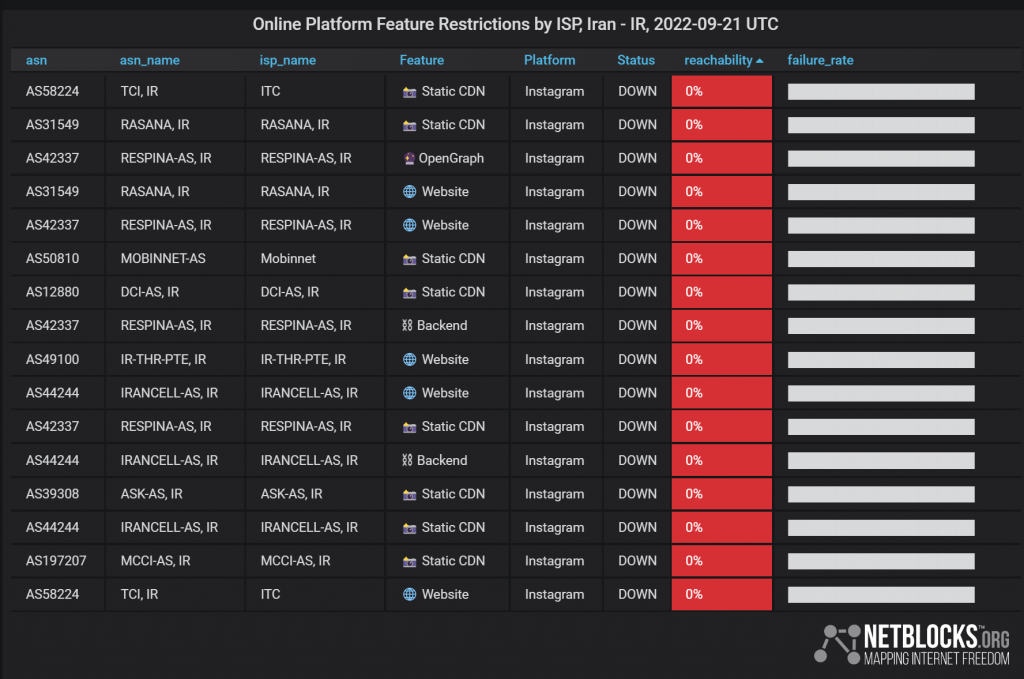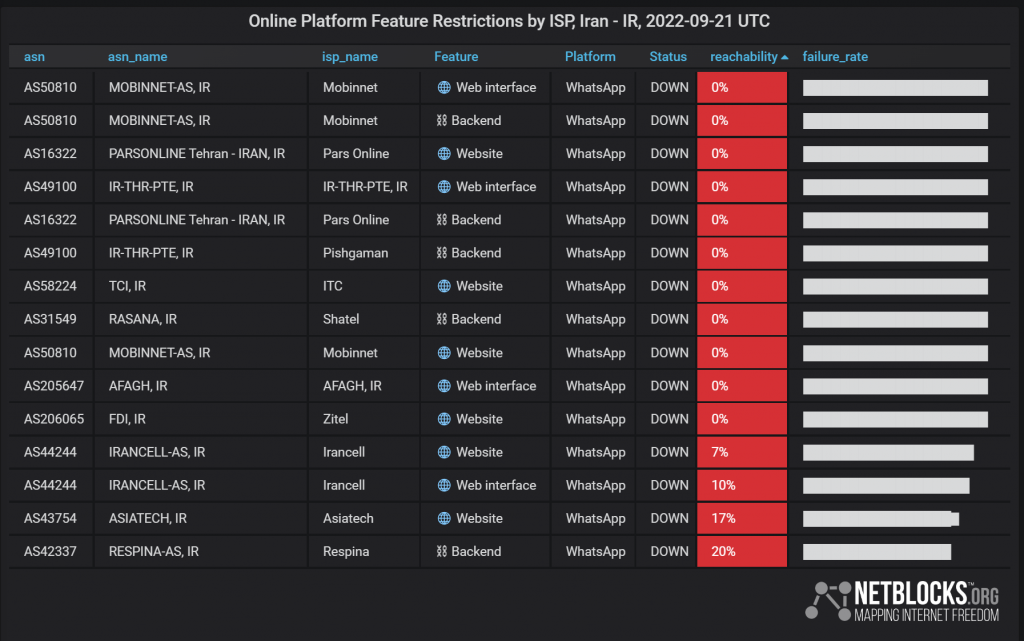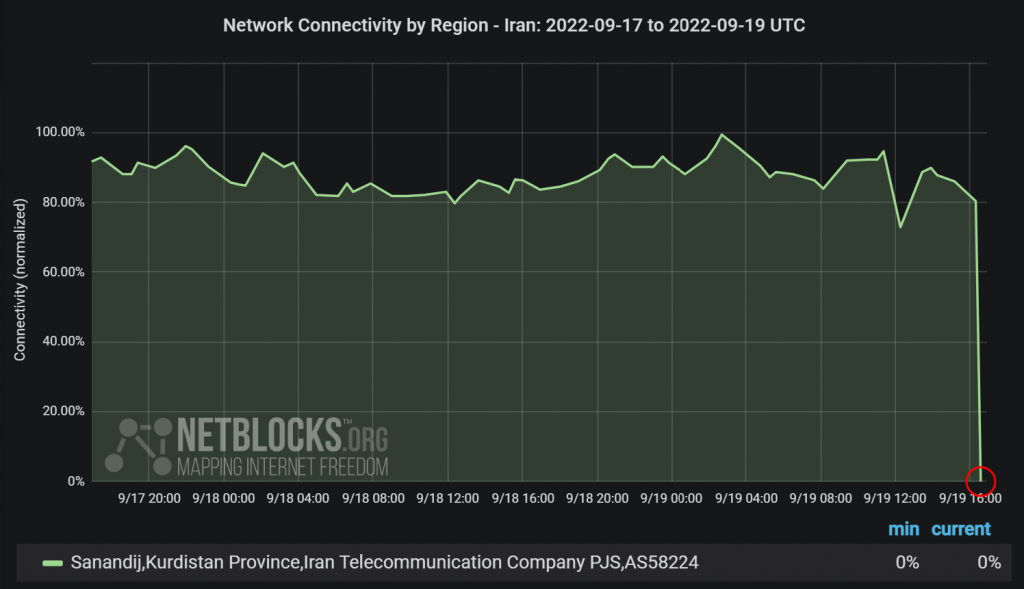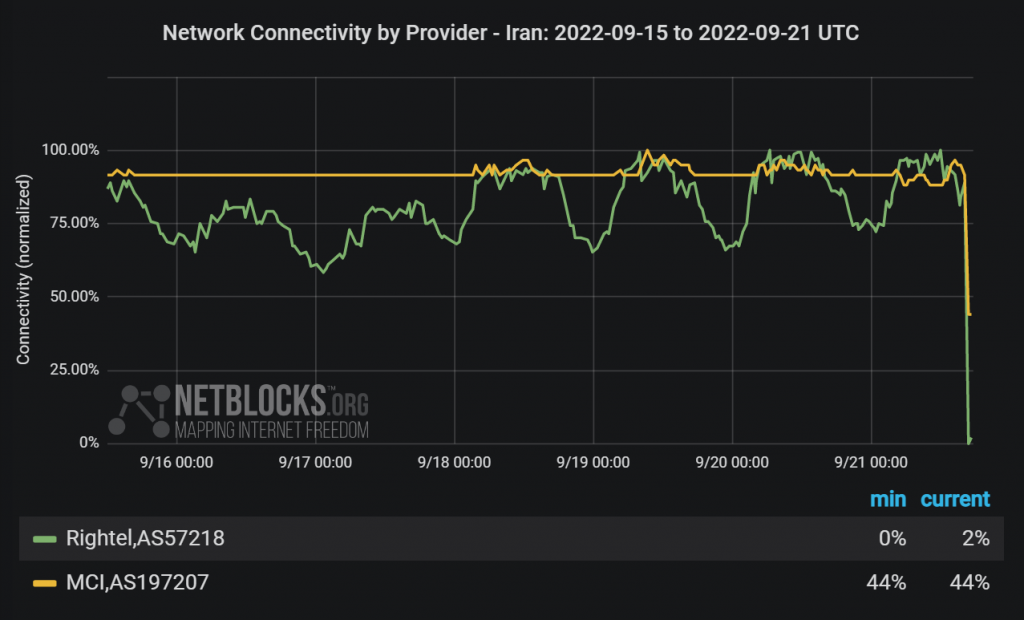Network data from NetBlocks confirm a near-total disruption disruption to internet service in parts of Kurdistan province in west Iran from the evening of Monday 19 September 2022. The regional telecommunications blackout in and around Sanandaj follows a partial disruption to internet service in Tehran and other parts of the country on Friday when protests first broke out. Instagram and WhatsApp, two of the last remaining international platforms in Iran, have subsequently been restricted nationally as of Wednesday 21 September, followed by a nation-scale shutdown of mobile networks.
Despite temporary restorations of mobile internet service since Thursday morning, online platforms have remained restricted and connectivity is intermittent for many users. Daily curfew-style mobile internet disruptions have continued until 4 October 2022.
The incidents come amid widening protests against the government after the death of Mahsa Amini from Saqqez in Kurdistan province after her arrest by Iran’s morality police for allegedly violating Iran’s strict hijab headscarf rules.
⚠️ Confirmed: Real-time network data show a near-total disruption to internet connectivity in #Sanandaj, the capital of Kurdistan Province in west #Iran; the incident comes amid widening protests over the death of #MahsaAmini after her arrest by morality police ? pic.twitter.com/wZVHJjgpiR
— NetBlocks (@netblocks) September 19, 2022
Observable connectivity was restored some 3.5 hours after the disruption came into place in Iran’s Kurdistan region, amid reports of at least four protesters killed by authorities. Users have also reported the disconnection or severe slowing of internet service in multiple cities since the first disruption was registered on Friday 16 September 2022.
⚠️ Confirmed: A significant internet outage has been registered in Tehran, #Iran with real time network data showing connectivity at 67% of ordinary levels; the incident comes amid protests over the death of Mahsa Amini and may affect coverage of events on the ground ? pic.twitter.com/a8fjaaLoYG
— NetBlocks (@netblocks) September 16, 2022
This class of internet disruption affects connectivity at the network layer and cannot generally be worked around with the use of circumvention software or VPNs.
On Wednesday 21 September 2022, access to Instagram and WhatsApp, some of the last remaining international social media and messaging platforms in Iran, was restricted across all major internet providers. Other platforms such as Twitter, Facebook have already been banned for several years:
⚠️ Confirmed: Access to Instagram, one of the last available social media platforms in #Iran, has been restricted amid protests over the death of #MahsaAmini; live metrics show frontends and CDNs now disrupted on multiple internet providers
? Background: https://t.co/8cCHIJA2Oi pic.twitter.com/PmNQOIGMDg
— NetBlocks (@netblocks) September 21, 2022
Access to messaging app WhatsApp was restricted across multiple internet providers shortly after Instagram:
⚠️ Confirmed: Messaging app #WhatsApp has been restricted in #Iran amid widening protests over the death of #MahsaAmini; metrics show WhatsApp servers now disrupted on multiple internet providers, hours after the restriction of Instagram
? Background: https://t.co/8cCHIJAADQ pic.twitter.com/JvzemCJ92s
— NetBlocks (@netblocks) September 21, 2022
These online communication platform restrictions are in place nationally and have been extended to cover LinkedIn and Skype in the following days.
Mobile networks including MCI, Iran’s leading cellular operator, were subsequently disrupted leaving many internet users completely offline in a country that is highly dependent on mobile service:
⚠️ Confirmed: Real-time network data show a nation-scale loss of connectivity on MCI (First Mobile), #Iran's leading mobile operator, and Rightel; the incidents come amid widespread protests over the death of #MahsaAmini ?
? Background: https://t.co/8cCHIJA2Oi pic.twitter.com/8FY4TIOJdI
— NetBlocks (@netblocks) September 21, 2022
These mobile disruptions have continued daily in a curfew-style rolling manner through to Friday, while the platform restrictions have remained in place throughout:
⚠️ Confirmed: Mobile internet has been disrupted in #Iran for a third time; live metrics show a nation-scale loss of connectivity on leading cellular operator MCI (First) amid protests over the death of #MahsaAmini
? Live Feed: https://t.co/nrj1jLGe9K
? https://t.co/8cCHIJAADQ pic.twitter.com/ReUloXle9m— NetBlocks (@netblocks) September 23, 2022
On Monday 26 September, Internet connectivity was disrupted at Iran’s elite Amirkabir University amid reports that students had gone on strike over the death of Mahsa Amini. Meanwhile, the previously observed pattern of nation-scale mobile internet disruptions and social media restrictions continued:
⚠️ Confirmed: Live metrics show the loss of internet connectivity at #Amirkabir University in #Iran as students strike over the death of #MahsaAmini.
Meanwhile:
▶️ Daily mobile disruptions continue
▶️ Social media restrictions remain in place? Report: https://t.co/8cCHIJA2Oi pic.twitter.com/fGKr4QGW9b
— NetBlocks (@netblocks) September 26, 2022
On the evening of Tuesday 27 September 2022, a major anomaly was identified on Iran’s backbone internet provider TCI, which is responsible for the nation’s telecommunication affairs. Users reported the loss of service even when using VPN services that can sometimes work around government filtering measures. Metrics show a significant collapse in connectivity as compared to predicted levels for the time and day in question:
⚠️ Confirmed: Real-time network data show an ongoing anomaly on internet backbone provider TCI in #Iran; the incident is likely to limit the free flow of information amid protests over the death of #MahsaAmini
? Background: https://t.co/8cCHIJA2Oi pic.twitter.com/0JqiyBmeCB
— NetBlocks (@netblocks) September 27, 2022
On Friday 30 September 2022, a major regional telecoms disruption was registered in Zahedan, Sistan and Baluchestan Province, amid deadly clashes with security forces that left several dead as well as the torching of police bases, in what many saw as an escalation in the intensity of protests and government crackdown:
⚠️ Confirmed: Live network data show a regional internet disruption in effect in #Zahedan, Sistan and Baluchestan, #Iran amid deadly clashes with security forces; the incident extends existing information controls since the death of #MahsaAmini
? Report: https://t.co/8cCHIJirpI pic.twitter.com/niIx20OF7h
— NetBlocks (@netblocks) September 30, 2022
Hours later on Friday, an additional regional network blackout was imposed in Kurdistan Province, the birthplace of Mahsa Amini and a flashpoint for protests, with the capital Sanandaj and nearby cities sent fully offline:
⚠️ Confirmed: Real-time network data show a new regional internet blackout in and around Sanandaj and #Kurdistan Province in #Iran; the incident follows a similar move in Zahedan today amid escalating protests over the death of #MahsaAmini
? Background: https://t.co/8cCHIJirpI pic.twitter.com/iIIz0WCWaK
— NetBlocks (@netblocks) September 30, 2022
On Thursday 8 December 2022, internet connectivity was disrupted in and around Sanandaj and Kurdistan Province for some seven hours amid protests over the execution of Iranian demonstrator Mohsen Shekari and the killing of Houman Abdollahi.
⚠️ Confirmed: Metrics show a disruption to internet connectivity in and around Sanandaj, #Kurdistan Province in #Iran on 8 December; the ~7 hour incident comes amid after the killing of #HoumanAbdollahi and protests over the execution of #MohsenShekari
? https://t.co/8cCHIJAADQ pic.twitter.com/zkq9AVBwvi
— NetBlocks (@netblocks) December 9, 2022
The network disruptions are likely to severely limit the public’s ability to express political discontent and communicate freely. NetBlocks recommends against the use of network disruptions to counter protests, given their disproportionate impact to fundamental rights including freedom of expression and freedom of assembly.
Recent internet shutdowns and disruptions in Iran
Iran has faced a series of network disruptions in recent years, with some attributed to external factors, and others to state information controls or targeted internet shutdowns. NetBlocks investigations have helped identify the root causes of these network outages.
Notably, in November 2019 Iran shut down internet access nationally amid widespread public protests that were met with deadly force by authorities. In that instance, users gradually regained access as connectivity was selectively brought back after a week of near-total outages.
Further reading:
- Iran restricts access to Instagram, WhatsApp as protests intensify – NetBlocks – Reuters
- Iran shutters mobile networks, Instagram, WhatsApp amid protests – The Record
- Four killed in Iran during protests over death in custody – rights group – Reuters
- Iran sees third day of protests after death of woman in police custody – Deutsche Welle
- Musk’s Starlink broadband company will seek exemption to sanctions so it can cover Iran – Sky News
- Internet restricted in Iran as anti-government protests intensify – Axios
- Iran reins in access to Instagram and WhatsApp, last platforms available to Iranians – Reporters Without Borders
- Iran: 14 journalists detained amid protests – International Federation of Journalists
- Iran woman’s death after morals police arrest sparks protests – Reuters
- Internet partially restricted after the death of a young woman in Iran – Heise
- Death after arrest by the vice squad – Deutsche Welle
- Mahsa Amini: Women take headscarves off in protest at funeral – BBC


Methodology
NetBlocks diffscans, which map the IP address space of a country in real time, show internet connectivity levels and corresponding outages. Purposeful internet outages may have a distinct network pattern used by NetBlocks to determine and attribute the root cause of an outage, a process known as attribution which follows detection and classification stages.
Internet performance and service reachability are determined via NetBlocks web probe privacy-preserving analytics. Each measurement consists of latency round trip time, outage type and autonomous system number aggregated in real-time to assess service availability and latency in a given country. Network providers and locations are enumerated as vantage point pairs. The root cause of a service outage may be additionally corroborated by means of traffic analysis and manual testing as detailed in the report.
NetBlocks is an internet monitor working at the intersection of digital rights, cyber-security and internet governance. Independent and non-partisan, NetBlocks strives to deliver a fair and inclusive digital future for all.
[ press | contact ] Graphics and visualizations are provided for fair use in unaltered form reflecting the meaning and intent in which they were published, with clear credit and source attribution to NetBlocks. Intellectual property rights are protected including but not limited to key findings, facts and figures, trademarks, copyrights, and original reporting, are held by NetBlocks. Citation and source attribution are required at the point of use.
Reporting Sponsor: Surfshark


